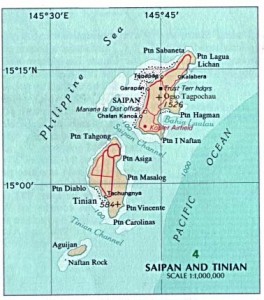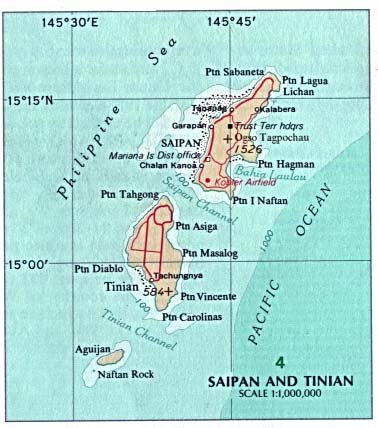 I’m sorry but I really don’t see why Guam can’t take the Marines. The base is big and I really think this will boost Guam’s economy.
I’m sorry but I really don’t see why Guam can’t take the Marines. The base is big and I really think this will boost Guam’s economy.
Check out this article:
TOKYO — Attention, Marines: If you need a new home for those helicopters on Okinawa, give Tinian a call. The tiny mid-Pacific island is waiting to hear from you.
That’s the message from leaders on the Commonwealth of the Northern Marianas Islands, according to a spokesman for Gov. Benigno R. Fitial.
“We would be willing to consider any relocation the government would present to us,” said spokesman Tom Linden, who serves as coordinator of the commonwealth’s Military Integration Management Committee.
When asked Thursday if that could include permanently playing host to as many as 4,000 Marines and helicopters comprising air operations at Marine Corps Air Station Futenma — the focus of a U.S.-Japan stalemate involving relocation of the base on Okinawa — Linden said it depends on what Pentagon leaders ultimately want.
“If they wish, I guess it would,” he said during a phone interview.
It was not known what the military thought of the idea. A phone call to the Joint Guam Program Office, the military office on Guam charged with coordinating the buildup, was not returned Thursday.
Japanese officials on a committee to look at alternatives to hosting Marine air operations on Okinawa met this week with Guam officials and Fitial to discussed options there and on Tinian and other islands in the commonwealth. Under a 2006 U.S.-Japan military realignment pact, Japan is to pay nearly 60 percent of the projected $10.6 billion cost of relocating Marines from Okinawa to Guam.
Tinian’s interest in hosting U.S. military troops is a far cry from growing concerns on Okinawa and Guam, where the issues include, respectively, the continued presence and the impending arrival of thousands of Marines.
“We would like to see some military buildup in the area,” Linden said this week. “Tinian has been waiting for 30 years. They have been expecting to have a military buildup for quite some time.”
The Manhattan-size island, a major launching point for B-29 bombing missions of Japan during World War II, lies about 80 miles north of Guam.
So far, the military wants to use Tinian as a training area for the 8,600 troops from III Marine Expeditionary Force who are expected to move from Okinawa to Guam by 2014.
That training would require four small-arms ranges and a 1,000-square-meter area to allow platoons to conduct maneuvering exercises, according to John Jackson, a retired Marine Corps colonel who is director for the Guam program office. As many as 300 Marines would come monthly for week-long training. They would bring their own supplies, set up their own tents and stay on their own land.
Some in the commonwealth, which consists of 15 islands including Saipan and Rota, say current military plans for Tinian aren’t mutually beneficial. Specifically, they say the Marines’ training proposal may not mitigate for what the local economy could lose — access to chili pepper crops, grazing lands and tourist attractions like the runway the B-29 “Enola Gay” used as it took off to drop an atomic bomb on Hiroshima, according to Phillip Mendiola-Long, the current president of Tinian’s chamber of commerce.
“The chamber supports the buildup,” Mendiola-Long said during a phone call earlier this week. “But we have to have an equal partner. We’re going to start to slide.”
Yet it’s unclear, at this point, whether the Marines would be allowed any liberty time to spend money on the island. That’s what has some worried and looking for more military investment.
For more than three decades the military has leased nearly 28 square miles on Tinian, an area that covers two-thirds of an island that has fewer than 3,000 residents and no stop light. Past military training there was infrequent but significant, local and military officials said. Every two to three years, a few hundred troops would drop in for two to three weeks to train and spend money.
“The local hotels would fill,” Mendiola-Long said. “We’d run out of money in the ATMs.”
Vendors would sell food, and troops on liberty would gamble in the island’s sole casino, he added.
Between training sessions, the military land remained open to the public.
When the military announced nearly four years ago it would use Tinian for more frequent training, commonwealth leaders grew interested, Mendiola-Long said. But they found out late last year that the military plans for Tinian involve only expeditionary training.
The Marines “must be able to defend, deter, meet treaty obligations or any other contingency,” said Col. Robert Loynd, one of two Marines on Guam who currently make up Marine Forces Pacific (Forward) Guam, the unit proposed to grow to 8,600 Marines.
That could mean tourist areas could be closed for portions of the training, according to Jackson. It would periodically cut access to the island’s main north-south road, he added. And, while military construction might add a couple hundred temporary jobs to the island, overall the military estimates it will need 12 to 15 full-time jobs to work security, clean out temporary toilets and cut back brush.
“We’re going to cut the grass and clean up the poo-poo?” said Mendiola-Long, with a hint of indignation.
Linden says Fitial is working with Guam leaders to find ways the proposed buildup could benefit Tinian more. The Futenma offer is part of those plans.
“The feeling is that Guam is getting all the money with very little lost,” Linden said. “On Tinian, the military is going to use more land, with next to no economic impact.”
References:
http://www.stripes.com/article.asp?section=104&article=67975




Another article:
http://www.stripes.com/article.asp?section=104&article=67976
Japanese panel likes Tinian option
By Chiyomi Sumida, Stars and Stripes
Pacific edition, Saturday, February 13, 2010
GINOWAN, Okinawa — A Japanese committee sent to Guam to review possible sites for relocating a Marine Corps air station from Okinawa, wrapped up their two-day visit Thursday with a clear sense that Guam already has too much on its plate.
But they left encouraged with the island of Tinian, 80 miles to the north, as a possible site to move some military training, according to Diet member Mikio Shimoji, a representative from Okinawa and part of the 23-member delegation that toured Guam bases and spoke with island officials.
Shimoji said the governor of the Commonwealth of the Northern Marianas Islands, Benigno Fitial, told him that he would like to make four of the 15 islands in the commonwealth available for U.S. military training. Shimoji said he was unable to visit Tinian, but did spend two hours Wednesday with Fitial and other officials on Saipan.
“It was very encouraging,” Shimoji said in a telephone interview upon his return to Tokyo on Thursday evening. “While Okinawa will continue to host military bases, risk-sharing is important.”
He said the panel also was handed a resolution passed by the Guam legislature that states the current plan for the massive military buildup on Guam needs to be restudied because of the islanders’ concerns for the environment and impact on the local population.
The plan is part of a military realignment pact the U.S. and Japan struck in 2006. Under the agreement, Japan would pay $6.1 billion of the projected $10.6 billion cost to relocate Marines to Guam from Okinawa.
Shimoji said the panel will relay the resolution to Prime Minister Yukio Hatoyama, along with Guam Gov. Felix Camacho’s statement that Guam could not handle any more than the 8,000 Marines already scheduled to transfer to the island.
Shimoji said he pledged to be a voice for Guam in the Japanese Diet.
“Besides the Marines and their families from Okinawa, Guam is expected to accept thousands more,” he said, indicating the island’s population will bulge with construction workers and other personnel to support the buildup. “Under those circumstances, it is not appropriate to add further troops to Guam.”
[…] here: Marines in Tinian, Not Guam? | Edel Alon Share and […]